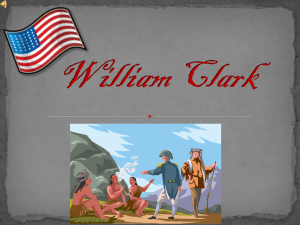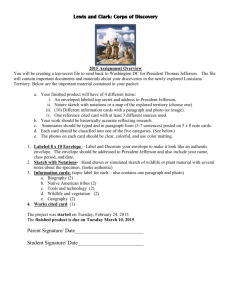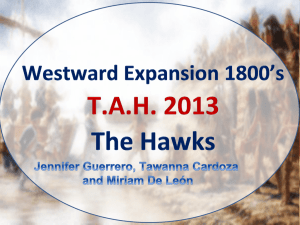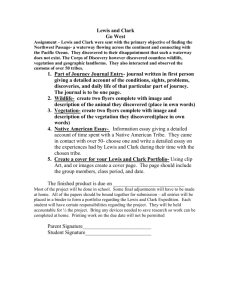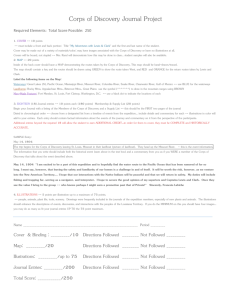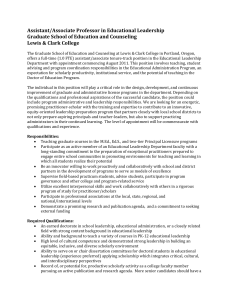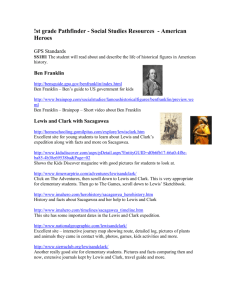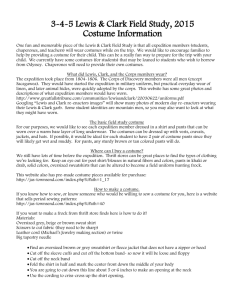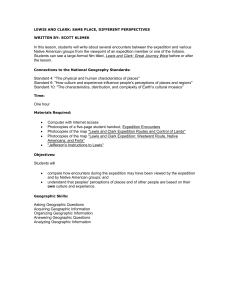A Backpack Full of Lewis and Clark Lesson Plan
advertisement
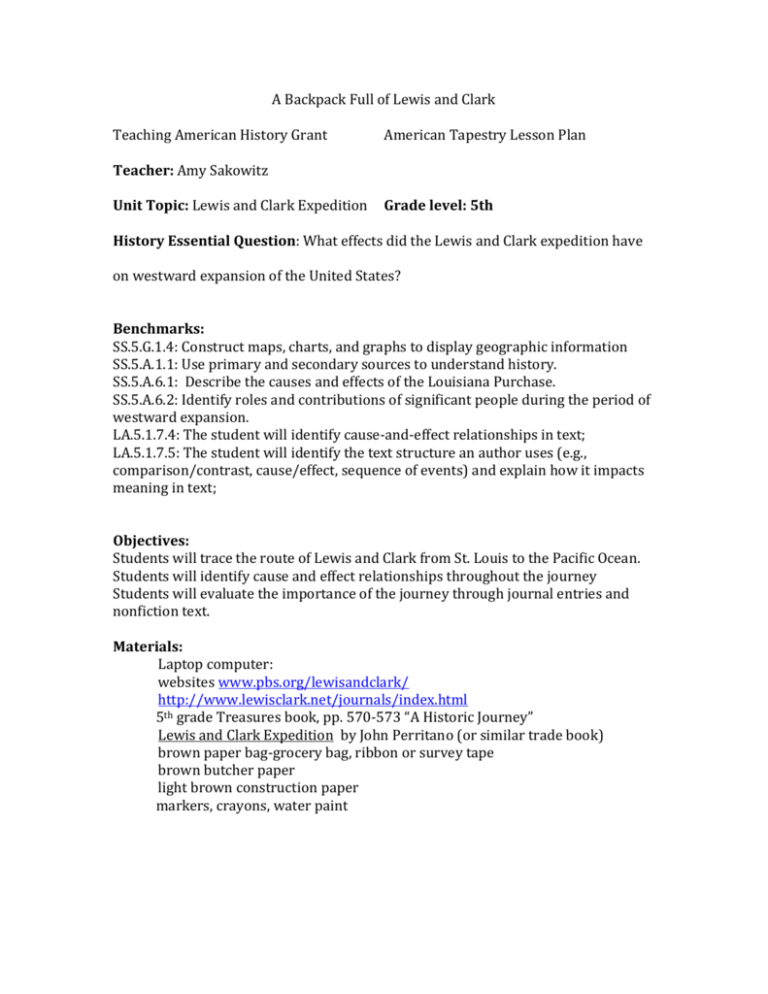
A Backpack Full of Lewis and Clark Teaching American History Grant American Tapestry Lesson Plan Teacher: Amy Sakowitz Unit Topic: Lewis and Clark Expedition Grade level: 5th History Essential Question: What effects did the Lewis and Clark expedition have on westward expansion of the United States? Benchmarks: SS.5.G.1.4: Construct maps, charts, and graphs to display geographic information SS.5.A.1.1: Use primary and secondary sources to understand history. SS.5.A.6.1: Describe the causes and effects of the Louisiana Purchase. SS.5.A.6.2: Identify roles and contributions of significant people during the period of westward expansion. LA.5.1.7.4: The student will identify cause-and-effect relationships in text; LA.5.1.7.5: The student will identify the text structure an author uses (e.g., comparison/contrast, cause/effect, sequence of events) and explain how it impacts meaning in text; Objectives: Students will trace the route of Lewis and Clark from St. Louis to the Pacific Ocean. Students will identify cause and effect relationships throughout the journey Students will evaluate the importance of the journey through journal entries and nonfiction text. Materials: Laptop computer: websites www.pbs.org/lewisandclark/ http://www.lewisclark.net/journals/index.html 5th grade Treasures book, pp. 570-573 “A Historic Journey” Lewis and Clark Expedition by John Perritano (or similar trade book) brown paper bag-grocery bag, ribbon or survey tape brown butcher paper light brown construction paper markers, crayons, water paint Assessment: Students will create a backpack with various items from the Lewis and Clark Expedition enclosed in it: 1. Map of the expedition showing the route to and from the Pacific Ocean 2. Original journal entries with excerpts from authentic ones 3. Time line of events4. 2-3 primary sources 5. foldable of people, places and items plants/animals Procedure: Day 1-Teacher will show Schoolhouse Rock “Elbow Room’ to introduce westward expansion. Teacher will read Lewis and Clark Expedition orally to class. While reading she will ask questions regarding cause/effect situations, and remind students of the chronological listing of the events in the story. Next, students will work in groups using trade books or “A Historic Journey” to locate various information such as people, places, and items, and plants and animals place on a “four door” foldable. Cause and Effect Questions: 1. What caused Jefferson to send Lewis and Clark on their expedition? 2. What was the effect of the Louisiana Purchase on the size of the United States? 3. Why did Lewis give the Natives gifts? 4. What was the result did finding the Great Falls? 5. For what reason was Fort Clatsop built? 6. Why do you think the men brought back many plants and animals? Day 2- Chronological order lesson- looking at a time line on www.pbs.org/lewisandclark/ students will list 6-8 places/events that occurred on the journey on a sheet of paper. Transfer onto construction paper creating a timeline, stating the date, the event, and the result. Day 3- Project map of US(attached) during the time of Louisiana Purchase showing the shape of the United States and the amount of land gained by that purchase., Using brown butcher paper, trace an outline of the US(attached) at that time period. Then trace the route of the explorers from 1804-1806 noting 2 events from each year. Place a star on every main stop along the way until they reach the Pacific Ocean. Write a brief description of each location and what happened there on the map. Decorate paper to look like an old map. Possibly burn edges, drip tea or crumple up. Day 4-During language arts use laptops to access http://www.lewisclark.net/journals/index.html to locate journal entries of either explorer. Choosing two entries from events listed on the timeline, create journal entries about each situation. What did you see, hear, smell, and feel? Take direct quotes from authentic entries and embed in individual entries using quotation marks. Day 5- Students research online to locate a list of items that Lewis and Clark brought with them. www.pbs.org/lewisandclark/ List at least 8-10 items and why those things were important to the expedition.- Students locate 2-3 primary sources and print out. Glue on outside of paper bag, with caption explaining it. Assemble the backpack using the Bag Ladies directions(attached) Place all items in the backpack for students to share or keep as a review. Extensions: 1. Lewis and Clark spent time with many Indian Tribes and learned many of their values and customs. Create a talking stick with real tree branches, duct tape, and feathers. Sit in circle and take turns discussing events of the expedition. 2. Play the Lewis and Clark game http://www.nationalgeographic.com/west/main.html

